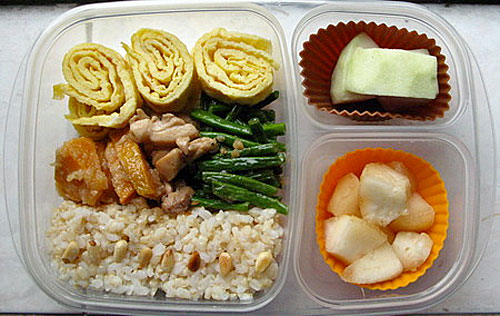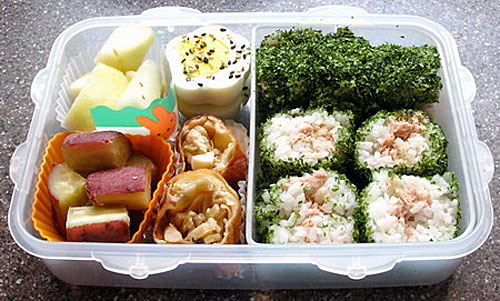Using bentos to deal with food sensitivities gracefully
This is a guest post by niceties of Main-Main Masak-Masak, where she blogs about how she deals with her food intolerences and dietary preferences. I've been an admirer of her calm, elegant and very informative essays for quite a long time, so I'm really happy to have her on board as a guest blogger!
Many thanks to Maki for inviting me to write this guest post for Just Bento. I'm particularly honoured as Maki's Just Hungry site taught me a lot about Japanese food when I began to take cooking more seriously and was also the main inspiration for my own foray into food blogging.
It was because of increasingly complex food sensitivities that I was motivated to learn more about cooking and bento culture, so as to be able to adapt recipes and to make my packed meals from home more appetising. The principles of bento culture go a long way in making our food-intolerance-friendly lunchboxes more tasty and attractive. Learning to be creative in those two areas is particularly important when one is faced with the limitations of food restrictions. Here is a quick guide to my approach to bento for special diets, summarising the key ideas I've mentioned across many different postings on my blog.
Choosing foods for bento

Food intolerances and special diets (including vegetarian, vegan, halal, kosher etc.) vary greatly from individual to individual, so only you know best what you can or can't eat. Even if you do not have food sensitivities, one of the great advantages of making your own bento meals is having the opportunity to provide yourself with healthy, nutritious, fresh food that is free of processed products, preservatives and artificial additives.
Bento don't have to be filled with Japanese food, as Lunch In A Box demonstrates (as does Just Bento! -ed). My main suggestion to managing food intolerances would be to seek out ingredients and cooking methods from a broad range of food cultures. For example, many gluten-free flours are commonplace in Indian cooking, so I head to an Indian supermarket to stock up on flours for western-style gluten-free baking, and also have the option of making Indian snacks from these same ingredients. Trying new foods and new tastes may take some getting used to but the more cosmopolitan your palate is, the wider your options for finding foods within your restrictions.
When it comes to unfamiliar cuisines, it's worthwhile doing some background reading on the properties of ingredients and how to handle them, the principles of cooking methods, as well as to understand how tastes & textures are combined. For example, you might want to find out which dishes taste good at room temperature if you don't have the opportunity to heat up your bento. Also, don't forget that some ingredients turn rancid quickly, especially in hot weather, including coconut milk.
Once you understand the fundamental principles of cooking across different food cultures, it will open up many possibilities for almost limitless experimentation. I'm not a purist when it comes to cuisines and tastes -- one can't afford to be when faced with wide-ranging food sensitivities -- I'm only interested in creating a dish that is palatable to myself.
Planning bento meals

The five principles of traditional Japanese cooking, which are also applied to bento, are extremely useful in putting together a meal that has a variety of colours (visual stimulation) and textures (sensory stimulation in your mouth); different nutrients (which foods of different colours are an indication of); a range of cooking styles; and the five tastes classified in Traditional Chinese Medicine (salty, sweet, sour, bitter and spicy/pungent) which help to ensure a meal balanced in yin/yang as well as other as oriental medicine concepts. Although it may not always be possible to fulfil these criteria, paying some attention to them will certainly pay off. Again, the wider your repertoire of ingredients, cooking methods and flavours, the more likely you will be able to come up with a combination that comes close to creating the variety of colours, textures and tastes that make an appealing bento.
Packing bento
Perhaps the first thing many people associate with bento culture are the elaborate kyaraben or charaben (character bento), but as Maki has demonstrated on Just Bento, everyday bento don't have to be that difficult. However, the fundamental ideas of packing bento can take your lunchbox from unappetising mess to something to look forward to. It feels really good when instead of being pitied for one's food intolerances, people think your food looks better than theirs!
You don't need to do cutesy or complicated, but it helps to have some aesthetic sense to guide you in composition, arrangement and the juxtaposition of colours and shapes. Frank Tastes provides some excellent examples of simple, almost Zen-like bento arrangments. As with developing any kind of artistic sensibility, exposure to as many examples as possible will build up your visual 'vocabulary' to facilitate creativity. Apart from the plethora of bento websites, if you have access to a Japanese bookstore, do browse through Japanese-language books on bento for inspiration -- the bento examples and the overall art direction are usually absolutely excellent.
It's also important to choose a box of the correct shape and size. A shallow box is better as it allows you to lay out the foods horizontally, almost like a painting. Also, if the foods come up to the lid when the box is sealed, they won't move around during transportation and your bento will still be intact when you come to eating it.
Maki has often discussed the usefulness of bento in controlling portion sizes, and Japanese guidelines on the optimal size for men, women and children are very useful. However, I have also discovered that the volume I can finish in one meal differs according to the type of food. The type of rice makes a huge difference, not so much in terms of managing the caloric value as Maki mentioned, but in terms of how much is enough to make me feel full. With brown rice, I eat much less than the half-box portion of sticky, short-grain Japanese white rice recommended for standard Japanese bento, and it's likely you'll find that with long-grain white rice typical of Southeast Asia and in southern Chinese cuisines, you'll need quite a bit more than that. Any kind of glutinous (aka sticky or sweet) rice would be the most filling of all.
Noodle dishes are a different ball game because not only do I consume a larger volume than if I had a meal of brown rice and side dishes, you need some empty space in your bento box to allow you to loosen the noodles and pick up the strands, or to toss the noodles with the topping ingredients (in terms of presentation, noodles look much nicer with the toppings heaped on top than ready mixed).
Stocking up on bento equipment

It might seem indulgent to buy lots of different plastic boxes, but given the importance of choosing the right box, it is worthwhile to do so. Daiso and Lock n Lock provide good selections at affordable prices. Wherever possible, choose airtight boxes as they will prevent spillage of any sauce or liquid contents (I've packed soups and yoghurt before), while also keeping dry foods like biscuits crisp in humid weather.
Beside the main lunchbox, I also have a selection of other plastic boxes: smaller ones for pieces of cut fruit (which accompany every meal bento I have), a round box for a single muffin, a deep, rectangular box for two muffins, and shallow rectangular boxes for angular snacks like pieces of cake. Most of my plastic boxes are not reserved for bento use only as we use them for storing all sorts of foods at home, such as dried goods removed from plastic packaging or leftovers in the fridge/freezer. With a large variety of plastic boxes on hand, I can easily find one to suit anything I want to pack into my bento bag. Aside from boxes, I regularly carry a small insulated mug/flask, and always have a wet towel (oshibori) and plastic cutlery -- either a fork and spoon in a ziploc bag or foldable chopsticks which come in their own case.
You'll need a bag to hold all these things. Again, it's good to have bags in different sizes to accommodate the amount of food you'll need. The bags I use most of the time hold my lunch, fruit and a snack. I also have one larger bag, which can also fit a one litre water bottle, and several smaller zipper or drawstring bags from Daiso which hold a single plastic box and cutlery and sometimes also an oshibori. Usually, the small zipper/drawstring bag will go inside my main holdall or backpack, where it helps to keep the food items together and hopefully, prevent the food boxes from being knocked open as well. If you do mostly rice bento rather than sandwiches, it's much better to find a bag that will allow you to hold the bento boxes horizontally. Briefcase-style lunchbags tilt your boxes on their side and may disturb the arrangement of food or increase the chance of spillage. It's not necessary to go hunting for dedicated lunch bags; any small tote bag with a large enough flat base will do, although I am very partial to two-layer bags that enable easy access to the main lunchbox itself.
Getting into a routine
When I first started making bento, I would spend ages planning the combination of foods and how to pack them. Now, I don't bother much with the intensive planning, I use the same foods from regular meals served at home and just try to pack them with a little bit of thought to presentation. After a while, you will develop better instincts at quickly sizing up the right box to choose and the best way to pack the food into the box.
Part of managing food sensitivities is also about developing a routine to make sure that you always have home-prepared food with you. This involves setting aside the time to cook and bake in large quantities, freeze them in individual portions which can then be quickly reheated and packed to go, as well as setting aside time before leaving the house to get it all together. Ever since I made the extra effort to always have food on me, even a small snack so that I'm never caught out, I hardly ever suffer unpleasant food reactions from eating something I wasn't supposed to anymore. Feeling well makes the effort all worthwhile.
On that note, I wish all of you happy, healthy bento-ing.
If you enjoyed this article, please consider supporting this site by becoming my patron via Patreon.
